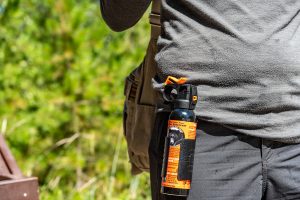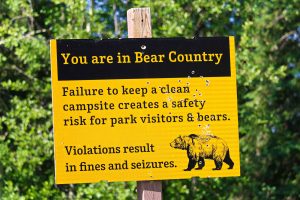
A grizzly bear in Yellowstone National Park. (Image by Nagel Photography, Shutterstock)
For most people, grizzly bears, also known as North American brown bears (or “grizzlies”), roam far from their homes and are not a thought in their daily lives. You may have admired these massive bears on nature shows from the comfort of your living room. And the thought of encountering a grizzly bear in real life may not even cross one’s mind while outdoors.
But in some states — whether you live in that state or you’re visiting — you’ll need to get to know more about safety in grizzly bear country and become bear aware. According to the Center for Biological Diversity, today grizzly bears live only in Alaska, Wyoming, Montana, Idaho, Washington, and parts of southern Colorado. Grizzly bears can reach up to 800 pounds and can stand 8 feet tall. They also have tremendous strength.
Grizzly bears and black bears can potentially attack a human during an encounter in the wild, but the reasons for those attacks are usually different.
According to Dr. Stephen Herrero, a bear expert and author of Bear Attacks: Their Causes and Avoidance, grizzly bears are more likely to attack humans as a defensive response when they perceive the human as a threat to their territory or food source, whereas black bear attacks are often a result of the bear being startled or attracted to food odors or garbage.

Image by mikluha_maklai, Shutterstock
So, if you’re exploring outdoors in any of the states where grizzly bears live in the wild, understand that grizzly bears (although awe-inspiring and adorable) are powerful predators that you don’t want to underestimate. When you’re outdoors, enjoying activities like camping and hiking, it’s essential to have knowledge about bear safety before you encounter a bear so you know what to do.
Imagine you go on a solo camping trip in the backcountry, and you suddenly come face-to-face with a grizzly bear. Your heart races as you try to recall everything you’ve learned about bear safety. You reach for your bear spray, but you realize you stored it away in your backpack temporarily and it’s not readily accessible. At that moment, you realize your lack of preparation could have negative consequences. This scenario highlights how important it is to be prepared and knowledgeable about grizzly bear safety.
These five safety tips will help you gain some basic bear safety knowledge and help you better understand what to do if you encounter a grizzly bear. Remember, a little preparation can go a long way in preventing a potentially dangerous encounter with a grizzly bear.

Image by Aleksei Potov, Shutterstock
1. Make Noise At Camp Or While Hiking
When you make noise while at camp or hiking on the trail, you can help prevent a surprise encounter. The noise doesn’t have to be obnoxiously loud. You could simply talk or sing to alert bears to your presence or wear bells on your backpack or clothing. Yelling or shouting at intervals can also help.
Dr. Tom Smith, a bear researcher and professor at Brigham Young University, explains, “Making noise lets bears know you’re there and reduces the likelihood of a surprise encounter. By being aware of your presence, bears can avoid you or prepare for a confrontation if necessary.”
You can learn more about preventing grizzly bear encounters on the National Park Service website.

2. Learn To Store Food And Scented Items Properly
Whether you’re camping at the same location for a few nights or backpacking — camping in multiple locations along a trail in grizzly bear country — avoid keeping food, garbage or scented items inside your tent at night.
Instead, learn to store these items properly to avoid attracting a grizzly bear to your camp. Spend some time researching bear-safe containers to find one that works for you as far as size and weight. Think of preparing to store things like scented deodorants, perfumes (which you should avoid packing in general) and foods like protein bars, chips, oatmeal and leftovers from dinner.
According to the U.S. National Park Service, “Food and other scented items should be stored at least 10 feet off the ground and 4 feet away from the trunk of a tree.” If you follow these basic storage tips, you can help reduce the chances of a grizzly bear entering your camp.

Image by Lost_in_the_Midwest, Shutterstock
3. Carry — And Know How To Use — Bear Spray
If you’re planning to camp or hike in grizzly bear country, having bear spray (a form of pepper spray) on you at the ready can be a good line of defense if you unexpectedly encounter a grizzly. But simply having bear spray on you isn’t enough. You need to know how to properly use it — especially in a moment of surprise when everything happens fast. If you know how to use your bear spray before you head out, you can feel confident that you could defend yourself if necessary.
One thing you can do to educate yourself on the ins and outs of using your bear spray is to buy a test bottle of bear spray from your local sporting goods store. Practice using it at home before you go out. Get to know the spray range, how to aim it and how to quickly remove it from your belt or harness.
Know where to aim if you happen to encounter a grizzly bear. Some experts recommend aiming at the eyes, nose and mouth if the bear is in close range as it could increase the chances of stopping the bear’s aggressive behavior and giving you time to escape. Other experts recommend spraying your bear spray like a cloud between you and the bear and emptying your can.
It’s important to understand that bear spray is not a guarantee of safety and should be used only as a last resort when other preventive measures have failed.

Image by Amelia Martin, Shutterstock
4. Respect Grizzly Bear Territory
Respecting the territory where grizzly bears live is essential to staying safe. In general, grizzlies are territorial. They need their space to avoid conflicts with humans. If you see fresh grizzly bear tracks, scat or claw marks, set up your camp far from that area. The best way to avoid an encounter is to put space between you and grizzlies.
And if you do see a grizzly bear, never approach the bear — especially for taking photos. The best way to photograph a grizzly bear is with a telephoto lens so you can keep your distance. Respect grizzly bears by giving them a lot of space and doing your best to not disturb their habitat in any way.

Image by MPH Photos, Shutterstock
5. Know What To Do In A Grizzly Bear Encounter
First, you should train yourself to tell the difference between a grizzly bear from a black bear, since what to do in an encounter with a grizzly bear is different from a black bear.
A few ways to identify a grizzly bear is by its shape, color and face. In general, grizzly bears have a distinctive hump of muscle on their shoulder and are light to dark brown in color. Black bears have no hump and are typically black — although there are brown or cinnamon-colored black bears. A grizzly bear’s face is rounder and more dished in shape, while a black bear’s face is pointed.
Dr. Lynn Rogers, a renowned bear expert and founder of the North American Bear Center, explains, “The most important thing is to not run. Running triggers the bear’s chase response, which is usually its predatory response. Stand your ground, and don’t back away.”
Common mistakes people make when encountering a grizzly bear include running and playing dead — which can encourage the bear to continue an attack.
If you encounter a grizzly bear up close while camping or hiking in the backcountry, here are three things you can do to avoid an attack:
- Stand your ground and make noise. By standing your ground and making yourself look as big as possible — like raising your hands and spreading your legs — along with speaking firmly and loudly. you’re letting the bear know you are a human and not a prey animal.
- Use bear spray. If you have your bear spray readily accessible, spray the bear directly in the face, aiming at the eyes and nose.
- Gradually back away. If the bear has not attacked, slowly move away and give the grizzly bear plenty of space to leave. Again, never turn your back on a grizzly bear or run.
According to Smith, “Using bear spray and standing your ground are the most effective ways to deter a grizzly bear if it approaches too closely.”
Learn more about bear safety on websites like Bearsmart.
Suzanne Downing is an outdoor writer and photographer in Montana with an environmental science journalism background. Her work can be found in Outdoors Unlimited, Bugle Magazine, Missoulian, Byline Magazine, Communique, MTPR online, UM Native News, National Wildlife Federation campaigns and more.
 Your Privacy Choices
Your Privacy Choices
 The
The